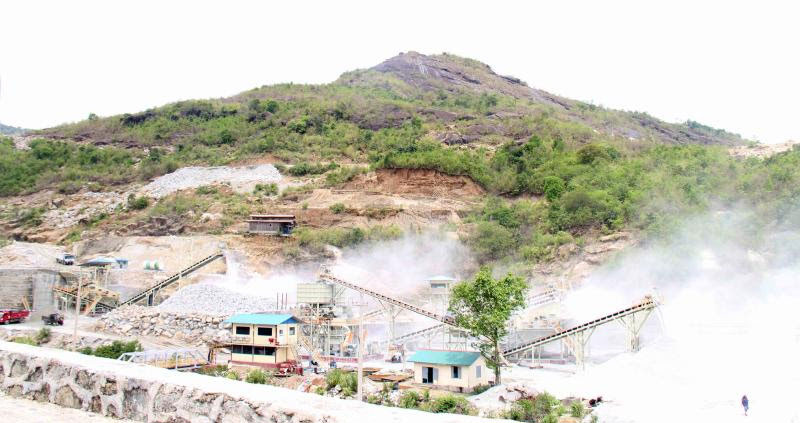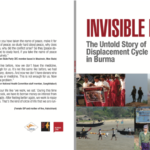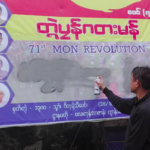By Phyo Thiha Cho / Mizzima News | June 21, 2016
On a recent afternoon in May, the farmers of OhnTitbin Village Tract were tending to their betel nut and rubber plantations when a loud blast erupted at the foot of Kalama Mountain and shook the ground.
Workers had set off an explosion in a local quarry located about 10 km away and a cloud of dust drifted out from the area towards the plantations here in Mon State, southeastern Myanmar.
Farmer Nyan Htay said several blasts occurred every day after quarrying had increased in the area in recent years. The resulting increase in pollution, he said, has affected the local environment and the harvest of his 6-acre rubber plantation.
“I earned about 6 million kyats (about US$5,000) in previous years, but it has declined to just 3 million kyats,” complained the ethnic Karen villager.
Farmers in the area, which comprises six villages with Bamar, Karen, Pa-O and Mon residents, said that since 2011 authorities had allowed companies to rapidly expand the extraction of rock stone to make gravel, while paying little attention to its environmental impact.
Waste and dust has polluted air and water sources, they said, while explosions have disrupted the underground water table and caused cracks in the walls of local homes and Buddhist pagodas. Swathes of forest around the quarries that were used by villagers to collect firewood and food, such as bamboo shoots, have been fenced off.
POLLUTED CREEKS, EMPTY WELLS
Khin Hla Cho, a woman from Ywakalay Village, said access to drinking water had become problematic. “We have to dig new wells as the old ones have dried up due to the explosions,” she said.
Htein Lin, a 55-year-old farmer in Pa-O Su Village, said he relied on a now polluted local creek and sediments in the water had gradually covered 5 out of his 6.5 acres of land. “I could only complain to the village administrator about the damage to my land, but nothing else happened,” he lamented.
Anger has long been building among the communities. In 2014, they sent a petition with 1,200 signatures to the President’s Office but received no reply. Recently, they sent letters to the National League for Democracy (NLD) government in Naypyitaw and Mon State government demanding actions against the quarries.
On June 5, desperate farmers staged a protest calling on Long Life Aggregate Mining Company to cease quarrying.
Shwe Thaung, the OhnTitbin Village Administrator, acknowledged the environmental problems, but said he was powerless to stop the companies as they had received long-running licenses from the previous government
“A creek that was a 100 feet wide in the past has now narrowed to about six feet because heaps of waste (from the quarries) were dumped in it,” he told Myanmar Now, adding that pollution had also affected his rubber plantation.
SUPPLYING EXPANDING INFRASTRUCTURE
More than 100 quarries have sprung up in recent years near the easily accessible mountains in Mon State, 22 of which are located in Paung and 48 in Kyaikhtotownship, according to Aye Zan, an NLD Mon State lawmaker who is studying the industry’s environmental impact.
On the eastern and western sides of Kalama Mountain, which dominates the region, six companies – Yarmanya, Long Life Aggregate Mining, Shwe Myint Moh Tun, Tun TaukSa, Azami and L.M. Jewellery – are extracting rock stone.
At the noisy, dusty quarries, dynamite and heavy machinery is used to break off large chunks of rocks from the mountainside, which are then crushed into gravel or smaller rocks that are loaded on to trucks.
The construction material is supplied to Myanmar’s growing number of road and infrastructure works, as well as government development projects, such as deep-sea ports and special economic zones at Thilawa near Yangon, and KyaukPhyu Island off Rakhine State.
Tin Ohn, general manager of Shwe Myint Moh Tun Company, said it held a 30-year license to quarry 50 acres of mountainside, adding that the firm produced around 400 tons of rocks per day destined for Thilawa SEZ.
“We operate quarries at a rocky mountainside that is not suitable for agriculture. We have approval of the Mon State government,” he said.
Tin Ohn downplayed the quarry’s environmental impacts, but added that affected farmers would be paid around $80 if they can show that a young rubber tree was destroyed by the company.
GOVERNMENT ACTION?
Tin Hla, a senior member of the Agriculture and Farmers Federation of Myanmar, which is supporting local communities, said some companies were breaching environmental rules by operating in the vicinity of farms, but authorities failed to act against them.
“According to the rules, quarries must be set up about 4 miles (6.7 km) away from villages,” he said, adding that the companies made no effort to consult villagers or accept complaints about their operations.
Aye Zan, the NLD MP, said, “We can say for sure that these mining activities have negative environmental and social impacts, but we are still in the process of surveying all these mining sites in Mon State.
“After that we will table a bill in the Mon State parliament about this issue.”
Tun Ming Aung, a Paung Township state lawmaker with the NLD who raised the problems in the state legislature on June 2, said he would call for regulating the quarries when the complaints were properly documented.
“If people really suffer from these quarries we will try to stop them,” he said.
Min Kyi Win, the state’s Minister for Environmental Conservation and Natural Resources, told Myanmar Now that the environmental impacts were a concern, but added that the quarries were an important source of state government revenue.
“If our country has sufficient revenue… we don’t need to break up these mountains,” he said.
HtunKo, a 35-year-old farmer from Ook Tatar Village who has been protesting against Long Life Aggregate Mining Company, said residents’ livelihoods suffered greatly and he vowed they would continue to fight against the mining.
“Our campaign will continue until the company moves away from this area,” he said.
This article originally appeared on Mizzima News on June 21, 2016.







